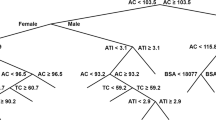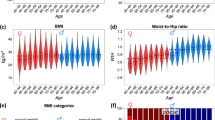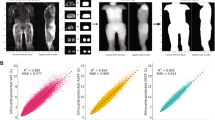Abstract
A long-standing question in nutrition and obesity research involves quantifying the relationship between body fat and anthropometry. To date, the mathematical formulation of these relationships has relied on pairing easily obtained anthropometric measurements such as the body mass index (BMI), waist circumference, or hip circumference to body fat. Recent advances in 3D body shape imaging technology provides a new opportunity for quickly and accurately obtaining hundreds of anthropometric measurements within seconds, however, there does not yet exist a large diverse database that pairs these measurements to body fat. Herein, we leverage 3D scanned anthropometry obtained from a population of United States Army basic training recruits to derive four subpopulations of homogenous body shape archetypes using a combined principal components and cluster analysis. While the Army database was large and diverse, it did not have body composition measurements. Therefore, these body shape archetypes were paired to an alternate smaller sample of participants from the Pennington Biomedical Research Center in Baton Rouge, LA that were not only similarly imaged by the same 3D scanning machine, but also had concomitant measures of body composition by dual-energy X-ray absorptiometry body composition. With this enhanced ability to obtain anthropometry through 3D scanning quickly of large populations, our machine learning approach for pairing body shapes from large datasets to smaller datasets that also contain state-of-the-art body composition measurements can be extended to pair other health outcomes to 3D body shape anthropometry.
This is a preview of subscription content, access via your institution
Access options
Subscribe to this journal
Receive 12 print issues and online access
$259.00 per year
only $21.58 per issue
Buy this article
- Purchase on Springer Link
- Instant access to full article PDF
Prices may be subject to local taxes which are calculated during checkout



Similar content being viewed by others
References
Dublin LI, Lotka AJ, Metropolitan Life Insurance Company, Statistical Bureau, Metropolitan Life Insurance Company. Twenty-five years of health progress; a study of the mortality experience among the industrial policyholders of the Metropolitan Life Insurance Company 1911 to 1935. New York, San Francisco: Metropolitan Life Insurance Company; 1937. xi, p. 611 (incl. illus. (maps) tables, diagrs).
Heo M, Kabat GC, Gallagher D, Heymsfield SB, Rohan TE. Optimal scaling of weight and waist circumference to height for maximal association with DXA-measured total body fat mass by sex, age and race/ethnicity. Int J Obes (Lond). 2013;37:1154–60.
Heymsfield SB, Chirachariyavej T, Rhyu IJ, Roongpisuthipong C, Heo M, Pietrobelli A. Differences between brain mass and body weight scaling to height: potential mechanism of reduced mass-specific resting energy expenditure of taller adults. J Appl Physiol (1985). 2009;106:40–8.
Heymsfield SB, Peterson CM, Thomas DM, Heo M, Schuna JM Jr., Hong S, et al. Scaling of adult body weight to height across sex and race/ethnic groups: relevance to BMI. Am J Clin Nutr. 2014;100:1455–61.
Bouchard C. BMI, fat mass, abdominal adiposity and visceral fat: where is the ‘beef’? Int J Obes (Lond). 2007;31:1552–3.
Motamed N, Rabiee B, Hemasi GR, Ajdarkosh H, Khonsari MR, Maadi M, et al. Body roundness index and waist-to-height ratio are strongly associated with non-alcoholic fatty liver disease: a population-based study. Hepat Mon. 2016;16:e39575.
Tian S, Zhang X, Xu Y, Dong H. Feasibility of body roundness index for identifying a clustering of cardiometabolic abnormalities compared to BMI, waist circumference and other anthropometric indices: the China Health and Nutrition Survey 2008 to 2009. Medicine (Baltimore). 2016;95:e4642.
Maessen MF, Eijsvogels TM, Verheggen RJ, Hopman MT, Verbeek AL, de Vegt F. Entering a new era of body indices: the feasibility of a body shape index and body roundness index to identify cardiovascular health status. PLoS ONE. 2014;9:e107212.
The National Health and Nutrition Examination Survey (NHANES) Anthropometry Procedures Manual. CDC. CfDC January 2007. https://wwwn.cdc.gov/nchs/data/nhanes3/manuals/anthro.pdf.
Nordhamn K, Sodergren E, Olsson E, Karlstrom B, Vessby B, Berglund L. Reliability of anthropometric measurements in overweight and lean subjects: consequences for correlations between anthropometric and other variables. Int J Obes Relat Metab Disord. 2000;24:652–7.
Wang J, Bartsch G, Rahgavan SS, Yurik T, Peng G, Chen L, et al. Reliability of body circumference and skinfold measurements by observers trained in groups. Int J Body Comp Res. 2004;2:31–6.
Kuehnapfel A, Ahnert P, Loeffler M, Broda A, Scholz M. Reliability of 3D laser-based anthropometry and comparison with classical anthropometry. Sci Rep. 2016;6:26672.
Soileau L, Bautista D, Johnson C, Gao C, Zhang K, Li X, et al. Automated anthropometric phenotyping with novel Kinect-based three-dimensional imaging method: comparison with a reference laser imaging system. Eur J Clin Nutr. 2016;70:475–81.
Koepke N, Zwahlen M, Wells JC, Bender N, Henneberg M, Ruhli FJ, et al. Comparison of 3D laser-based photonic scans and manual anthropometric measurements of body size and shape in a validation study of 123 young Swiss men. PeerJ. 2017;5:e2980.
Stewart AD, Klein S, Young J, Simpson S, Lee AJ, Harrild K, et al. Body image, shape, and volumetric assessments using 3D whole body laser scanning and 2D digital photography in females with a diagnosed eating disorder: preliminary novel findings. Br J Psychol. 2012;103:183–202.
Loffler-Wirth H, Willscher E, Ahnert P, Wirkner K, Engel C, Loeffler M, et al. Novel anthropometry based on 3D-bodyscans applied to a large population based cohort. PLoS ONE. 2016;11:e0159887.
Reynolds G, Shendruk A. Demographics of the U.S. Military: Council on Foreign Relations. 2018. https://www.cfr.org/article/demographics-us-military.
Army Demographics FY16 Profile. 2016. https://m.goarmy.com/content/dam/goarmy/downloaded_assets/pdfs/advocates-demographics.pdf.
Yun DJ, Yun DK, Chang YY, Lim SW, Lee MK, Kim SY. Correlations among height, leg length and arm span in growing Korean children. Ann Hum Biol. 1995;22:443–58.
Bogin B, Varela-Silva MI. Leg length, body proportion, and health: a review with a note on beauty. Int J Environ Res Public Health. 2010;7:1047–75.
Jolliffe IT. Principal component analysis. 2nd ed. New York: Springer; 2002. xxix, p. 487.
DeGregory KW, Kuiper P, DeSilvio T, Pleuss JD, Miller R, Roginski JW, et al. A review of machine learning in obesity. Obes Rev. 2018;19:668–85.
US Army Training Center, Fort Jackson. 2018. http://jackson.armylive.dodlive.mil/about/. Accessed on 14 June 2018.
Military Recruitment 2010. National Priorities Projet. 2011. https://www.nationalpriorities.org/analysis/2011/military-recruitment-2010/. Accessed on 14 June 2018.
Varmuza K, Filzmoser P. Introduction to multivariate statistical analysis in chemometrics. Boca Raton: CRC Press; 2009. xiii, p. 321.
Freedman D, Pisani R, Purves R. Statistics. 4th ed. New York: W.W. Norton & Co.; 2007.
Army Regulation 600-9. The army body composition program. In: DoD, editor. Washington DC: The Department of the Army; 2013.
Gallagher D, Heymsfield SB, Heo M, Jebb SA, Murgatroyd PR, Sakamoto Y. Healthy percentage body fat ranges: an approach for developing guidelines based on body mass index. Am J Clin Nutr. 2000;72:694–701.
Heymsfield SB, Bourgeois B, Ng BK, Sommer MJ, Li X, Shepherd JA. Digital anthropometry: a critical review. Eur J Clin Nutr. 2018;72:680–7.
Bourgeois B, Ng BK, Latimer D, Stannard CR, Romeo L, Li X, et al. Clinically applicable optical imaging technology for body size and shape analysis: comparison of systems differing in design. Eur J Clin Nutr. 2017;71:1329–35.
Pradhan L, Song G, Zhang C, Gower B, Heymsfield S, Allison D, et al. editors. Feature extraction from 2D images for body composition analysis. IEEE International Symposium on Multimedia (ISM). Miami, FL, USA: IEEE; 2015.
Acknowledgements
Funding:
This work was partially supported by two National Institutes of Health NORC Center Grants P30DK072476, Pennington/Louisiana; and P30DK040561, Harvard; and R01DK109008, Shape UP! Adults.
Author information
Authors and Affiliations
Corresponding author
Ethics declarations
Conflict of interest
The authors declare that they have no conflict of interest.
Electronic supplementary material
Rights and permissions
About this article
Cite this article
Pleuss, J.D., Talty, K., Morse, S. et al. A machine learning approach relating 3D body scans to body composition in humans. Eur J Clin Nutr 73, 200–208 (2019). https://doi.org/10.1038/s41430-018-0337-1
Received:
Accepted:
Published:
Issue Date:
DOI: https://doi.org/10.1038/s41430-018-0337-1
This article is cited by
-
Mobile phone applications for 3-dimensional scanning and digital anthropometry: a precision comparison with traditional scanners
European Journal of Clinical Nutrition (2024)
-
Machine learning-based obesity classification considering 3D body scanner measurements
Scientific Reports (2023)
-
Translating digital anthropometry measurements obtained from different 3D body image scanners
European Journal of Clinical Nutrition (2023)
-
Associations between 3D surface scanner derived anthropometric measurements and body composition in a cross-sectional study
European Journal of Clinical Nutrition (2023)
-
Phenomic Imaging
Phenomics (2023)



